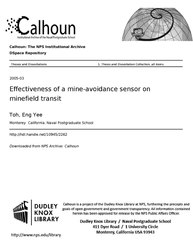File:Effectiveness of a mine-avoidance sensor on minefield transit (IA effectivenessofm109452262).pdf

Original file (1,275 × 1,650 pixels, file size: 871 KB, MIME type: application/pdf, 104 pages)
Captions
Captions
Summary[edit]
| Effectiveness of a mine-avoidance sensor on minefield transit
( |
||
|---|---|---|
| Author |
Toh, Eng Yee |
|
| Title |
Effectiveness of a mine-avoidance sensor on minefield transit |
|
| Publisher |
Monterey California. Naval Postgraduate School |
|
| Description |
Simulation is used to study the effectiveness of mine avoidance sonar (MAS) use on safe minefield transit by a ship. A MAS is able to detect mine-like objects but currently cannot classify the detected object as a mine or a non-mine mine-like bottom object (nombo). The tactic is to avoid all detected objects. The minefield is represented by a finite grid of fixed width and length. The representation of ship maneuvering in the simulation is similar to that of a wall tracing algorithm for a computer mouse going through a maze. The simulation results indicate that the use of the mine avoidance sonars can increase the probability of successful transit. The probability of successful transit increases as the probability of detection increases for minefield object densities less than 50% of the field. However, the probability of successful transit is sensitive to the mine and NOMBO (NOn-mine Mine-like Bottom Object) density. The probability of successful transit can be increased if the density of mine-like objects is decreased. Some suggestions on mine avoidance tactics are made from the results obtained to show the limitations and effectiveness of the MAS with regards to the open waters, narrow channels, ports and harbors. Subjects: Mines (Military explosives); Detection; Explosives; Harbors; Tactics |
|
| Language | English | |
| Publication date | March 2005 | |
| Current location |
IA Collections: navalpostgraduateschoollibrary; fedlink |
|
| Accession number |
effectivenessofm109452262 |
|
| Source | ||
| Permission (Reusing this file) |
This publication is a work of the U.S. Government as defined in Title 17, United States Code, Section 101. As such, it is in the public domain, and under the provisions of Title 17, United States Code, Section 105, may not be copyrighted. | |
Licensing[edit]
| Public domainPublic domainfalsefalse |
This work is in the public domain in the United States because it is a work prepared by an officer or employee of the United States Government as part of that person’s official duties under the terms of Title 17, Chapter 1, Section 105 of the US Code.
Note: This only applies to original works of the Federal Government and not to the work of any individual U.S. state, territory, commonwealth, county, municipality, or any other subdivision. This template also does not apply to postage stamp designs published by the United States Postal Service since 1978. (See § 313.6(C)(1) of Compendium of U.S. Copyright Office Practices). It also does not apply to certain US coins; see The US Mint Terms of Use.
|
 | |
| This file has been identified as being free of known restrictions under copyright law, including all related and neighboring rights. | ||
https://creativecommons.org/publicdomain/mark/1.0/PDMCreative Commons Public Domain Mark 1.0falsefalse
File history
Click on a date/time to view the file as it appeared at that time.
| Date/Time | Thumbnail | Dimensions | User | Comment | |
|---|---|---|---|---|---|
| current | 11:47, 18 July 2020 |  | 1,275 × 1,650, 104 pages (871 KB) | Fæ (talk | contribs) | FEDLINK - United States Federal Collection effectivenessofm109452262 (User talk:Fæ/IA books#Fork8) (batch 1993-2020 #14682) |
You cannot overwrite this file.
File usage on Commons
The following page uses this file:
Metadata
This file contains additional information such as Exif metadata which may have been added by the digital camera, scanner, or software program used to create or digitize it. If the file has been modified from its original state, some details such as the timestamp may not fully reflect those of the original file. The timestamp is only as accurate as the clock in the camera, and it may be completely wrong.
| Short title | Effectiveness of a mine-avoidance sensor on minefield transit |
|---|---|
| Author | Toh, Eng Yee |
| Software used | Toh, Eng Yee |
| Conversion program | GNU Ghostscript 7.06 |
| Encrypted | no |
| Page size | 612 x 792 pts (letter) |
| Version of PDF format | 1.4 |

